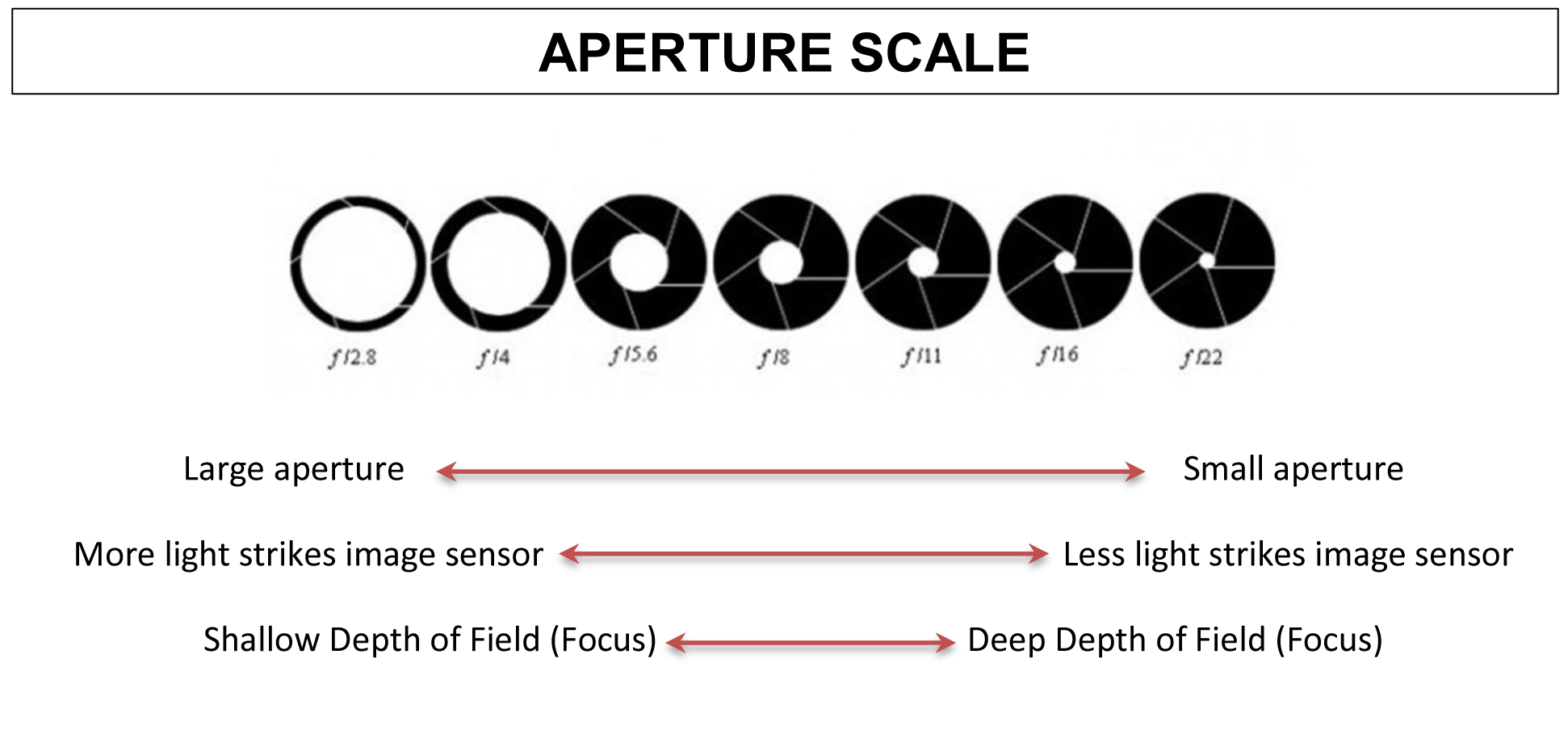
Exposure refers to two aspects of photography – the lightness and the darkness of the image.
If the shot is exposed too long the photograph will be washed out. If the shot is exposed too short the photograph will appear too dark.
The two primary controls your camera uses for exposure are shutter speed (the amount of time the sensor is exposed to light) and aperture (the size of the lens opening that lets light into the camera).
Shutter speeds are measured in seconds and more commonly fractions of a second. (1/2000 of a second is very fast and 8′ seconds is extremely slow).
Apertures are measured in something called f/stops (a very wide aperture is f/2.8 and a very small aperture is f/19).
Why there is not just a constant shutter speed or a constant aperture so that you would only have to worry about one control?
The reason is that even though they both control the amount of light getting to the sensor they also controls other aspects of the picture.
Shutter speed for example can be used to freeze subjects in mid-air with a fast speed or it can be used to blur water with a slow speed.
Aperture controls the depth-of-field which is what is in focus in the picture.
Aperture can be used to draw attention to one subject by blurring the background with a wide aperture (low f/stop).
Aperture can also be used to focus everything in a picture with a narrow aperture (high f/stop).
A good way to understand it is to "think of a bucket of water with a hole in the bottom. If you have a large hole in the bottom of the bucket (large aperture), water will drain out quickly (fast shutter speed). Conversely, for the same amount of water, if you have a small hole in the bottom of the bucket (small aperture), the water will drain out slowly (slow shutter speed)."
Composition & the Rule of Third
Composition is the placement or arrangement of visual elements or ingredients in a work of art, as distinct from the subject of a work. It can also be thought of as the organization of the elements of art according to the principles of art.
There are numerous approaches or "compositional techniques" to achieving a sense of unity within an artwork, depending on the goals of the artist.
Conventional composition can be achieved by utilizing a number of techniques, one of them is the Rule of Thirds.
Rule of thirds:
The rule of thirds is a guideline followed by some visual artists. The objective is to stop the subject(s) and areas of interest (such as the horizon) from bisecting the image, by placing them near one of the lines that would divide the image into three equal columns and rows, ideally near the intersection of those lines.
Depth of Field
A camera can only focus its lens at a single point, but there will be an area that stretches in front of and behind this focus point that still appears sharp.
This zone is known as the depth of field. It’s not a fixed distance, it changes in size and can be described as either ‘shallow’ (where only a narrow zone appears sharp) or deep (where more of the picture appears sharp).
Depth of field has an impact on both the aesthetic and technical quality of a picture. Sometimes you’ll want to use an extensive depth of field in order to keep everything sharp.
A classic example is when you’re photographing a landscape, where generally the most desirable outcome is to capture detail from the foreground to the horizon.
Other times, a shallow depth of field will be preferable. It enables you to blur background and foreground details, causing distractions to melt away and allowing you to direct viewers to the focal point in a picture.
Balance

What does balance in photography mean?
What does balance in photography mean?
Placing your main subject off-center, as with the rule of thirds, creates a more interesting photo, but it can leave a void in the scene which can make it feel empty. You should balance the "weight" of your subject by including another object of lesser importance to fill the space.
Formal balance.
There are basically two types of balance in photography. The first is formal balance, also called symmetrical balance. As the name suggest it is when one or more identical or similar subjects are repeated symmetrical on each sides of a given point. The formal balance is most often recognized by subjects that are uniform in shape.
Informal balance.
The second type, informal balance or so called asymmetrical balance is when one or more dissimilar elements are balancing on each side of a given point. Informal balance is less obvious because the subjects are not uniform. A well made image using informal balance is more appealing to the viewer compared to a symmetrical composed image.
Various source was used in the making of this information about photography:
https://spot.pcc.edu/~mdembrow/glossary.htm
http://www.picturecorrect.com/tips/photography-exposure-basics/
http://www.wikihow.com/Understand-Camera-Exposure
http://en.wikipedia.org/wiki/Composition_(visual_arts)
http://digital-photography-school.com/5-elements-of-composition-in-photography/
http://en.wikipedia.org/wiki/Depth_of_field
https://photographylife.com/what-is-composition-in-photography
http://www.digitalcameraworld.com/2013/07/17/what-is-depth-of-field-how-aperture-focal-length-and-focus-control-whats-sharp/
https://sites.google.com/site/photographycompositionrules/balancing-elements
https://expertphotography.com/basic-composition-techniques-balance/
http://digital-photography-school.com/balance-in-photography/
http://www.eventbrite.com/e/get-to-know-your-digital-camera-part-2-all-about-exposure-tickets-16598522628
https://spot.pcc.edu/~mdembrow/glossary.htm
http://www.picturecorrect.com/tips/photography-exposure-basics/
http://www.wikihow.com/Understand-Camera-Exposure
http://en.wikipedia.org/wiki/Composition_(visual_arts)
http://digital-photography-school.com/5-elements-of-composition-in-photography/
http://en.wikipedia.org/wiki/Depth_of_field
https://photographylife.com/what-is-composition-in-photography
http://www.digitalcameraworld.com/2013/07/17/what-is-depth-of-field-how-aperture-focal-length-and-focus-control-whats-sharp/
https://sites.google.com/site/photographycompositionrules/balancing-elements
https://expertphotography.com/basic-composition-techniques-balance/
http://digital-photography-school.com/balance-in-photography/
http://www.eventbrite.com/e/get-to-know-your-digital-camera-part-2-all-about-exposure-tickets-16598522628

No comments:
Post a Comment